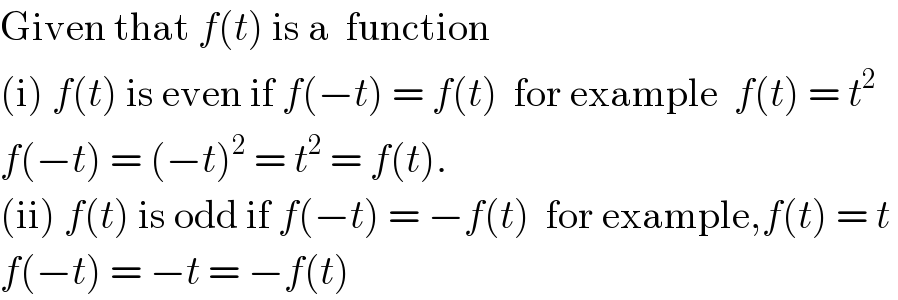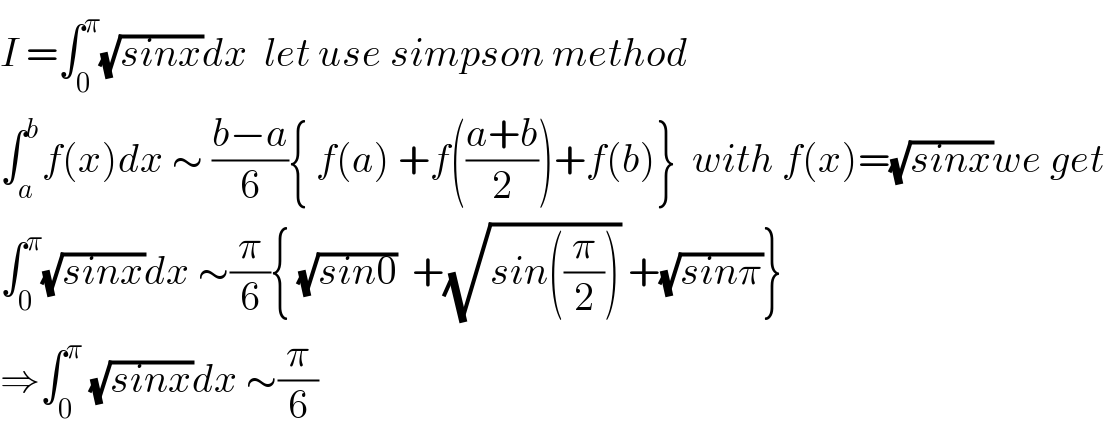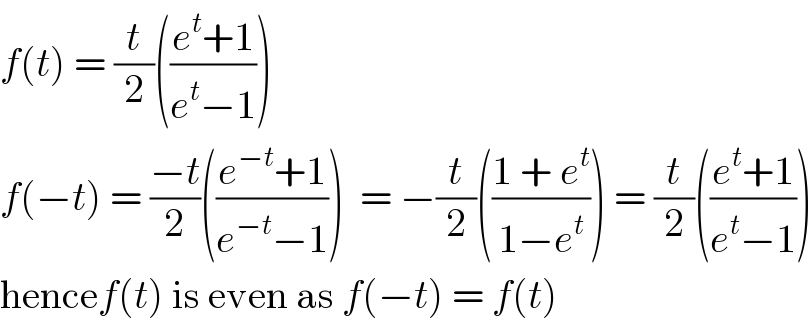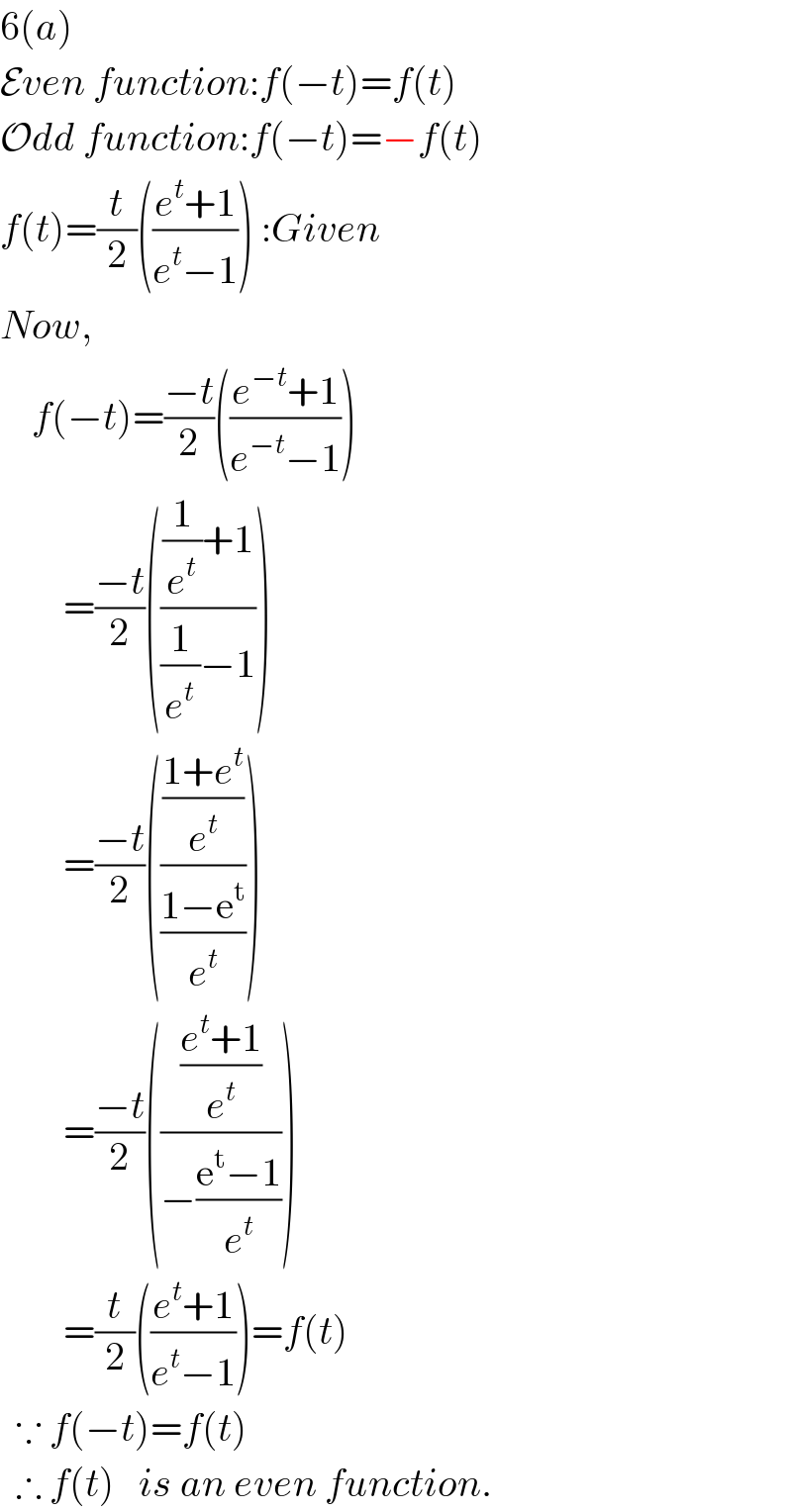Question Number 93733 by liki last updated on 14/May/20

Commented by liki last updated on 14/May/20

$$..\mathrm{please}\:\mathrm{help}\:\mathrm{qn}\:\mathrm{no}\:\mathrm{6a},\mathrm{b},\mathrm{c} \\ $$
Commented by Rio Michael last updated on 14/May/20

$$\mathrm{Given}\:\mathrm{that}\:{f}\left({t}\right)\:\mathrm{is}\:\mathrm{a}\:\:\mathrm{function}\: \\ $$$$\left(\mathrm{i}\right)\:{f}\left({t}\right)\:\mathrm{is}\:\mathrm{even}\:\mathrm{if}\:{f}\left(−{t}\right)\:=\:{f}\left({t}\right)\:\:\mathrm{for}\:\mathrm{example}\:\:{f}\left({t}\right)\:=\:{t}^{\mathrm{2}} \\ $$$${f}\left(−{t}\right)\:=\:\left(−{t}\right)^{\mathrm{2}} \:=\:{t}^{\mathrm{2}} \:=\:{f}\left({t}\right). \\ $$$$\left(\mathrm{ii}\right)\:{f}\left({t}\right)\:\mathrm{is}\:\mathrm{odd}\:\mathrm{if}\:{f}\left(−{t}\right)\:=\:−{f}\left({t}\right)\:\:\mathrm{for}\:\mathrm{example},{f}\left({t}\right)\:=\:{t}\: \\ $$$${f}\left(−{t}\right)\:=\:−{t}\:=\:−{f}\left({t}\right)\: \\ $$
Commented by Ritu Jain last updated on 14/May/20

$$\mathrm{hi}\:\mathrm{liki} \\ $$$$\mathrm{can}\:\mathrm{you}\:\mathrm{please}\:\mathrm{use}\:\mathrm{smaller}\:\mathrm{font}\:\mathrm{size}. \\ $$
Commented by mathmax by abdo last updated on 14/May/20

$$\left.{c}\right)\:{f}\left({x}\right)=\mathrm{2}+\sqrt{\mathrm{4}−{x}}\:{and}\:{g}\left({x}\right)={x}^{\mathrm{2}} \:+\mathrm{1}\:\Rightarrow{fog}\left({x}\right)={f}\left({g}\left({x}\right)\right) \\ $$$$=\mathrm{2}+\sqrt{\mathrm{4}−{g}\left({x}\right)}=\mathrm{2}+\sqrt{\mathrm{4}−{x}^{\mathrm{2}} −\mathrm{1}}=\mathrm{2}+\sqrt{\mathrm{3}−{x}^{\mathrm{2}} } \\ $$$${x}\in\:{D}_{{f}\mathrm{0}{g}} \:\Leftrightarrow\mathrm{3}−{x}^{\mathrm{2}} \geqslant\mathrm{0}\:\:\Leftrightarrow{x}^{\mathrm{2}} \:\leqslant\mathrm{3}\:\Leftrightarrow\:\:\:−\sqrt{\mathrm{3}}\leqslant{x}\leqslant\sqrt{\mathrm{3}}\:\:{but}\:{x}<\mathrm{0}\:\Rightarrow \\ $$$${D}_{{fog}} =\left[−\sqrt{\mathrm{3}},\mathrm{0}\left[\right.\right. \\ $$
Commented by liki last updated on 14/May/20

$$..\mathrm{thank}\:\mathrm{you}\:\mathrm{sir}\:\mathrm{i}\:\mathrm{appriciate}\:\mathrm{your}\:\mathrm{time}\:. \\ $$
Commented by mathmax by abdo last updated on 14/May/20
![8) the line x=3 is dircted by vector v=j(0,1) we have 2y−x =−2 ⇒x−2y =2 ⇒x−2y−2=0 ⇒this line is directed by u(2,1) ⇒(D,Δ) =(u,v) cos(u,v) =((u.v)/(∣∣u∣∣.∣∣v∣∣)) =(1/( (√5))) sin(u,v) =((det(u,v))/(∣∣u∣∣.∣∣v∣∣)) =( determinant (((2 0)),((1 1)))/( (√5))) =(2/( (√5))) ⇒tan(u,v) =2 ⇒ (u,v) =arctan(2)[π]](https://www.tinkutara.com/question/Q93747.png)
$$\left.\mathrm{8}\right)\:\:{the}\:{line}\:{x}=\mathrm{3}\:{is}\:{dircted}\:{by}\:{vector}\:{v}={j}\left(\mathrm{0},\mathrm{1}\right)\:\:{we}\:{have} \\ $$$$\mathrm{2}{y}−{x}\:=−\mathrm{2}\:\Rightarrow{x}−\mathrm{2}{y}\:=\mathrm{2}\:\Rightarrow{x}−\mathrm{2}{y}−\mathrm{2}=\mathrm{0}\:\Rightarrow{this}\:{line}\:{is}\:{directed}\:{by} \\ $$$${u}\left(\mathrm{2},\mathrm{1}\right)\:\Rightarrow\left({D},\Delta\right)\:=\left({u},{v}\right)\:\:\:\:{cos}\left({u},{v}\right)\:=\frac{{u}.{v}}{\mid\mid{u}\mid\mid.\mid\mid{v}\mid\mid}\:=\frac{\mathrm{1}}{\:\sqrt{\mathrm{5}}} \\ $$$${sin}\left({u},{v}\right)\:=\frac{{det}\left({u},{v}\right)}{\mid\mid{u}\mid\mid.\mid\mid{v}\mid\mid}\:=\frac{\begin{vmatrix}{\mathrm{2}\:\:\:\:\:\:\:\:\mathrm{0}}\\{\mathrm{1}\:\:\:\:\:\:\:\:\:\:\mathrm{1}}\end{vmatrix}}{\:\sqrt{\mathrm{5}}}\:=\frac{\mathrm{2}}{\:\sqrt{\mathrm{5}}}\:\Rightarrow{tan}\left({u},{v}\right)\:=\mathrm{2}\:\Rightarrow \\ $$$$\left({u},{v}\right)\:={arctan}\left(\mathrm{2}\right)\left[\pi\right] \\ $$
Commented by abdomathmax last updated on 15/May/20

$${you}\:{are}\:{welcome}\:. \\ $$
Commented by liki last updated on 15/May/20

$$..\mathrm{sory}\:\mathrm{sir}\:\mathrm{how}\:\mathrm{can}\:\mathrm{i}\:\mathrm{add}\:\mathrm{more}\:\mathrm{than}\:\mathrm{256}\:\mathrm{in}\:\mathrm{whatsap}\:\mathrm{group}?? \\ $$
Commented by mathmax by abdo last updated on 15/May/20
![A =∫_0 ^π (√(sinx))dx (its not simpson method) A =∫_0 ^(π/2) (√(sinx))dx +∫_(π/2) ^π (√(sinx))dx but ∫_(π/2) ^π (√(sinx))dx =_(x=(π/2)+t) =∫_0 ^(π/2) (√(cost))dt ⇒ A =∫_0 ^(π/2) (√(sinx))dx +∫_0 ^(π/2) (√(cosx))dx =A_1 +A_2 we have x−(x^3 /6)≤sinx ≤x for x∈[0,(π/2)] ⇒ (√(x−(x^3 /6)))≤(√(sinx))≤(√x) ⇒∫_0 ^(π/2) (√(x−(x^3 /6)))dx ≤A_1 ≤∫_0 ^(π/2) (√x)dx but ∫_0 ^(π/2) (√x)dx =_((√x)=t) ∫_0 ^(√(π/2)) t(2t)dt =2[(t^3 /3)]_0 ^(√(π/2)) =(2/3)×(π/2)(√(π/2))= (π/3)(√(π/2)) ∫_0 ^(π/2) (√(x−(x^3 /6)))dx =∫_0 ^(π/2) (√x)(√(1−(x^2 /6)))dx =_((√x)=t) ∫_0 ^(√(π/2)) t(√(1−(t^4 /6)))(2t)dt =2 ∫_0 ^(√(π/2)) t^2 (√(1−(t^4 /6)))dt but we know (1+u)^(1/2) =1+(u/2)+(((1/2)((1/2)−1))/2)u^(2 ) +...=1+(u/2)−(u^2 /8) ⇒ 1+(u/2)−(u^2 /8)≤(√(1+u))≤1+(u/2) ⇒1−(u/2)−(u^2 /8)≤(√(1−u))≤1−(u/2) ⇒1−(t^4 /(12))−(t^8 /(36×8)) ≤(√(1−(t^4 /6)))≤1−(t^4 /(12)) ⇒ t^2 −(t^6 /(12))−(t^(10) /(36×8)) ≤t^2 (√(1−(t^4 /6)))≤t^2 −(t^6 /(12)) ⇒ ∫_0 ^(√(π/2)) (2t^2 −(t^6 /6)−(t^(10) /(144)))dt ≤ ∫_0 ^(π/2) (√(x−(x^3 /6)))dx≤∫_0 ^(√(π/2)) (2t^2 −(t^6 /6))dt ∫_0 ^(√(π/2)) (2t^2 −(t^6 /6))dt =[(2/3)t^3 −(t^7 /(42))]_0 ^(√(π/2)) =(2/3)×(π/2)(√(π/2))−(1/(42))((√(π/2)))^7 ∫_0 ^(√(π/2)) (2t^2 −(t^6 /6)−(t^(10) /(144)))dt =[(2/3)t^3 −(t^7 /(42))−(t^(11) /(11×144))]_0 ^(√(π/2)) ....be continued....](https://www.tinkutara.com/question/Q93801.png)
$${A}\:=\int_{\mathrm{0}} ^{\pi} \sqrt{{sinx}}{dx}\:\:\:\left({its}\:{not}\:{simpson}\:{method}\right) \\ $$$${A}\:=\int_{\mathrm{0}} ^{\frac{\pi}{\mathrm{2}}} \:\sqrt{{sinx}}{dx}\:+\int_{\frac{\pi}{\mathrm{2}}} ^{\pi} \:\sqrt{{sinx}}{dx}\:{but}\:\int_{\frac{\pi}{\mathrm{2}}} ^{\pi} \:\sqrt{{sinx}}{dx}\:=_{{x}=\frac{\pi}{\mathrm{2}}+{t}} \\ $$$$=\int_{\mathrm{0}} ^{\frac{\pi}{\mathrm{2}}} \sqrt{{cost}}{dt}\:\Rightarrow\:{A}\:=\int_{\mathrm{0}} ^{\frac{\pi}{\mathrm{2}}} \:\sqrt{{sinx}}{dx}\:+\int_{\mathrm{0}} ^{\frac{\pi}{\mathrm{2}}} \sqrt{{cosx}}{dx}\:={A}_{\mathrm{1}} \:+{A}_{\mathrm{2}} \\ $$$${we}\:{have}\:{x}−\frac{{x}^{\mathrm{3}} }{\mathrm{6}}\leqslant{sinx}\:\leqslant{x}\:\:{for}\:{x}\in\left[\mathrm{0},\frac{\pi}{\mathrm{2}}\right]\:\Rightarrow \\ $$$$\sqrt{{x}−\frac{{x}^{\mathrm{3}} }{\mathrm{6}}}\leqslant\sqrt{{sinx}}\leqslant\sqrt{{x}}\:\Rightarrow\int_{\mathrm{0}} ^{\frac{\pi}{\mathrm{2}}} \sqrt{{x}−\frac{{x}^{\mathrm{3}} }{\mathrm{6}}}{dx}\:\leqslant{A}_{\mathrm{1}} \leqslant\int_{\mathrm{0}} ^{\frac{\pi}{\mathrm{2}}} \sqrt{{x}}{dx} \\ $$$${but}\:\int_{\mathrm{0}} ^{\frac{\pi}{\mathrm{2}}} \sqrt{{x}}{dx}\:=_{\sqrt{{x}}={t}} \:\:\:\int_{\mathrm{0}} ^{\sqrt{\frac{\pi}{\mathrm{2}}}} \:\:\:{t}\left(\mathrm{2}{t}\right){dt}\:=\mathrm{2}\left[\frac{{t}^{\mathrm{3}} }{\mathrm{3}}\right]_{\mathrm{0}} ^{\sqrt{\frac{\pi}{\mathrm{2}}}} \\ $$$$=\frac{\mathrm{2}}{\mathrm{3}}×\frac{\pi}{\mathrm{2}}\sqrt{\frac{\pi}{\mathrm{2}}}=\:\frac{\pi}{\mathrm{3}}\sqrt{\frac{\pi}{\mathrm{2}}} \\ $$$$\int_{\mathrm{0}} ^{\frac{\pi}{\mathrm{2}}} \sqrt{{x}−\frac{{x}^{\mathrm{3}} }{\mathrm{6}}}{dx}\:=\int_{\mathrm{0}} ^{\frac{\pi}{\mathrm{2}}} \sqrt{{x}}\sqrt{\mathrm{1}−\frac{{x}^{\mathrm{2}} }{\mathrm{6}}}{dx}\:=_{\sqrt{{x}}={t}} \:\:\int_{\mathrm{0}} ^{\sqrt{\frac{\pi}{\mathrm{2}}}} \:\:\:{t}\sqrt{\mathrm{1}−\frac{{t}^{\mathrm{4}} }{\mathrm{6}}}\left(\mathrm{2}{t}\right){dt} \\ $$$$=\mathrm{2}\:\int_{\mathrm{0}} ^{\sqrt{\frac{\pi}{\mathrm{2}}}} \:\:\:\:{t}^{\mathrm{2}} \sqrt{\mathrm{1}−\frac{{t}^{\mathrm{4}} }{\mathrm{6}}}{dt}\:\:\:{but}\:\:{we}\:{know}\: \\ $$$$\left(\mathrm{1}+{u}\right)^{\frac{\mathrm{1}}{\mathrm{2}}} \:=\mathrm{1}+\frac{{u}}{\mathrm{2}}+\frac{\frac{\mathrm{1}}{\mathrm{2}}\left(\frac{\mathrm{1}}{\mathrm{2}}−\mathrm{1}\right)}{\mathrm{2}}{u}^{\mathrm{2}\:} +…=\mathrm{1}+\frac{{u}}{\mathrm{2}}−\frac{{u}^{\mathrm{2}} }{\mathrm{8}}\:\Rightarrow \\ $$$$\mathrm{1}+\frac{{u}}{\mathrm{2}}−\frac{{u}^{\mathrm{2}} }{\mathrm{8}}\leqslant\sqrt{\mathrm{1}+{u}}\leqslant\mathrm{1}+\frac{{u}}{\mathrm{2}}\:\Rightarrow\mathrm{1}−\frac{{u}}{\mathrm{2}}−\frac{{u}^{\mathrm{2}} }{\mathrm{8}}\leqslant\sqrt{\mathrm{1}−{u}}\leqslant\mathrm{1}−\frac{{u}}{\mathrm{2}} \\ $$$$\Rightarrow\mathrm{1}−\frac{{t}^{\mathrm{4}} }{\mathrm{12}}−\frac{{t}^{\mathrm{8}} }{\mathrm{36}×\mathrm{8}}\:\leqslant\sqrt{\mathrm{1}−\frac{{t}^{\mathrm{4}} }{\mathrm{6}}}\leqslant\mathrm{1}−\frac{{t}^{\mathrm{4}} }{\mathrm{12}}\:\Rightarrow \\ $$$${t}^{\mathrm{2}} −\frac{{t}^{\mathrm{6}} }{\mathrm{12}}−\frac{{t}^{\mathrm{10}} }{\mathrm{36}×\mathrm{8}}\:\leqslant{t}^{\mathrm{2}} \sqrt{\mathrm{1}−\frac{{t}^{\mathrm{4}} }{\mathrm{6}}}\leqslant{t}^{\mathrm{2}} \:−\frac{{t}^{\mathrm{6}} }{\mathrm{12}}\:\Rightarrow\: \\ $$$$\int_{\mathrm{0}} ^{\sqrt{\frac{\pi}{\mathrm{2}}}} \:\:\:\left(\mathrm{2}{t}^{\mathrm{2}} −\frac{{t}^{\mathrm{6}} }{\mathrm{6}}−\frac{{t}^{\mathrm{10}} }{\mathrm{144}}\right){dt}\:\leqslant\:\int_{\mathrm{0}} ^{\frac{\pi}{\mathrm{2}}} \sqrt{{x}−\frac{{x}^{\mathrm{3}} }{\mathrm{6}}}{dx}\leqslant\int_{\mathrm{0}} ^{\sqrt{\frac{\pi}{\mathrm{2}}}} \:\:\:\left(\mathrm{2}{t}^{\mathrm{2}} −\frac{{t}^{\mathrm{6}} }{\mathrm{6}}\right){dt} \\ $$$$\int_{\mathrm{0}} ^{\sqrt{\frac{\pi}{\mathrm{2}}}} \:\:\left(\mathrm{2}{t}^{\mathrm{2}} −\frac{{t}^{\mathrm{6}} }{\mathrm{6}}\right){dt}\:=\left[\frac{\mathrm{2}}{\mathrm{3}}{t}^{\mathrm{3}} −\frac{{t}^{\mathrm{7}} }{\mathrm{42}}\right]_{\mathrm{0}} ^{\sqrt{\frac{\pi}{\mathrm{2}}}} \:=\frac{\mathrm{2}}{\mathrm{3}}×\frac{\pi}{\mathrm{2}}\sqrt{\frac{\pi}{\mathrm{2}}}−\frac{\mathrm{1}}{\mathrm{42}}\left(\sqrt{\frac{\pi}{\mathrm{2}}}\right)^{\mathrm{7}} \\ $$$$\int_{\mathrm{0}} ^{\sqrt{\frac{\pi}{\mathrm{2}}}} \:\:\left(\mathrm{2}{t}^{\mathrm{2}} −\frac{{t}^{\mathrm{6}} }{\mathrm{6}}−\frac{{t}^{\mathrm{10}} }{\mathrm{144}}\right){dt}\:=\left[\frac{\mathrm{2}}{\mathrm{3}}{t}^{\mathrm{3}} −\frac{{t}^{\mathrm{7}} }{\mathrm{42}}−\frac{{t}^{\mathrm{11}} }{\mathrm{11}×\mathrm{144}}\right]_{\mathrm{0}} ^{\sqrt{\frac{\pi}{\mathrm{2}}}} \\ $$$$….{be}\:{continued}…. \\ $$$$ \\ $$
Commented by mathmax by abdo last updated on 15/May/20

$${I}\:=\int_{\mathrm{0}} ^{\pi} \sqrt{{sinx}}{dx}\:\:{let}\:{use}\:{simpson}\:{method}\: \\ $$$$\int_{{a}} ^{{b}} {f}\left({x}\right){dx}\:\sim\:\frac{{b}−{a}}{\mathrm{6}}\left\{\:{f}\left({a}\right)\:+{f}\left(\frac{{a}+{b}}{\mathrm{2}}\right)+{f}\left({b}\right)\right\}\:\:{with}\:{f}\left({x}\right)=\sqrt{{sinx}}{we}\:{get} \\ $$$$\int_{\mathrm{0}} ^{\pi} \sqrt{{sinx}}{dx}\:\sim\frac{\pi}{\mathrm{6}}\left\{\:\sqrt{{sin}\mathrm{0}}\:\:+\sqrt{{sin}\left(\frac{\pi}{\mathrm{2}}\right)}\:+\sqrt{{sin}\pi}\right\} \\ $$$$\Rightarrow\int_{\mathrm{0}} ^{\pi} \:\sqrt{{sinx}}{dx}\:\sim\frac{\pi}{\mathrm{6}} \\ $$
Answered by Rio Michael last updated on 14/May/20

$$\mathrm{6}.\left(\mathrm{b}\right)\:{f}\left({x}\right)\:=\:\left({x}−\mathrm{2}\right)\left(\mathrm{8}−{x}\right)\:\mathrm{for}\:\mathrm{2}\:\leqslant\:{x}\leqslant\:\mathrm{8}\: \\ $$$$\left(\mathrm{i}\right)\:{f}\left(−\mathrm{1}\right)\:=\:\left(−\mathrm{1}−\mathrm{2}\right)\left(\mathrm{8}+\mathrm{1}\right)\:=\:−\mathrm{27} \\ $$$$\left(\mathrm{ii}\right)\:{f}\left(\mathrm{1}−\mathrm{2}{t}\right)\:=\:\left(\mathrm{1}−\mathrm{2}{t}−\mathrm{2}\right)\left(\mathrm{8}−\mathrm{1}\:+\mathrm{2}{t}\right)\:=\:\left(−\mathrm{1}−\mathrm{2}{t}\right)\left(\mathrm{9}−\mathrm{2}{t}\right)\:\:\mathrm{D}_{{f}} \::\:{t}\:\in\mathbb{R} \\ $$$$ \\ $$
Commented by Rasheed.Sindhi last updated on 15/May/20

$$\mathcal{T}{he}\:{function}\:{is}\:{defined}\:{in}\:{interval} \\ $$$$\mathrm{2}\:\leqslant\:{x}\leqslant\:\mathrm{8}.\:\mathcal{H}{ow}\:{can}\:{you}\:{calculate} \\ $$$${f}\left(−\mathrm{1}\right)? \\ $$$$\therefore\:{f}\left(−\mathrm{1}\right)\:{is}\:{undefined}! \\ $$
Answered by Rio Michael last updated on 14/May/20

$${f}\left({t}\right)\:=\:\frac{{t}}{\mathrm{2}}\left(\frac{{e}^{{t}} +\mathrm{1}}{{e}^{{t}} −\mathrm{1}}\right) \\ $$$${f}\left(−{t}\right)\:=\:\frac{−{t}}{\mathrm{2}}\left(\frac{{e}^{−{t}} +\mathrm{1}}{{e}^{−{t}} −\mathrm{1}}\right)\:\:=\:−\frac{{t}}{\mathrm{2}}\left(\frac{\mathrm{1}\:+\:{e}^{{t}} }{\mathrm{1}−{e}^{{t}} }\right)\:=\:\frac{{t}}{\mathrm{2}}\left(\frac{{e}^{{t}} +\mathrm{1}}{{e}^{{t}} −\mathrm{1}}\right) \\ $$$$\mathrm{hence}{f}\left({t}\right)\:\mathrm{is}\:\mathrm{even}\:\mathrm{as}\:{f}\left(−{t}\right)\:=\:{f}\left({t}\right) \\ $$
Answered by Rio Michael last updated on 14/May/20
![6(c) f(x) = 2+ (√(4−x)) and g(x) = x^2 +1 f o g = f[g(x)] = f(x^2 +1) = 2+ (√(4−x^2 −1)) = 2 + (√(3−x^2 )) D_(fg) : x∈R −{−(√3),(√3)} as an exercise find the range of your function](https://www.tinkutara.com/question/Q93740.png)
$$\mathrm{6}\left(\mathrm{c}\right)\:{f}\left({x}\right)\:=\:\mathrm{2}+\:\sqrt{\mathrm{4}−{x}}\:\mathrm{and}\:\mathrm{g}\left({x}\right)\:=\:{x}^{\mathrm{2}} \:+\mathrm{1} \\ $$$${f}\:{o}\:{g}\:=\:{f}\left[\mathrm{g}\left({x}\right)\right]\:=\:{f}\left({x}^{\mathrm{2}} \:+\mathrm{1}\right)\:=\:\mathrm{2}+\:\sqrt{\mathrm{4}−{x}^{\mathrm{2}} −\mathrm{1}}\:=\:\mathrm{2}\:+\:\sqrt{\mathrm{3}−{x}^{\mathrm{2}} }\:\mathrm{D}_{{fg}} \::\:\:{x}\in\mathbb{R}\:−\left\{−\sqrt{\mathrm{3}},\sqrt{\mathrm{3}}\right\} \\ $$$$\mathrm{as}\:\mathrm{an}\:\mathrm{exercise}\:\mathrm{find}\:\mathrm{the}\:\mathrm{range}\:\mathrm{of}\:\mathrm{your}\:\mathrm{function} \\ $$
Commented by liki last updated on 14/May/20

$$..\mathrm{Thank}\:\mathrm{you}\:\mathrm{very}\:\mathrm{much}\:\mathrm{sir}. \\ $$
Commented by mr W last updated on 14/May/20

$${you}\:{are}\:{requested}\:{to}\:{use}\:{a}\:{smaller} \\ $$$${font}\:{for}\:{your}\:{text}\:{sir}! \\ $$
Commented by Tinku Tara last updated on 14/May/20

$$\mathrm{Another}\:\mathrm{request}\:\mathrm{is}\:\mathrm{to}\:\mathrm{please}\:\mathrm{crop} \\ $$$$\mathrm{image}\:\mathrm{so}\:\mathrm{that}\:\mathrm{only}\:\mathrm{useful}\:\mathrm{portion} \\ $$$$\mathrm{is}\:\mathrm{posted}.\:\mathrm{Latest}\:\mathrm{verion}\:\mathrm{provides} \\ $$$$\mathrm{crop}\:\mathrm{function}\:\mathrm{which}\:\mathrm{uploading} \\ $$$$\mathrm{images}. \\ $$
Commented by Ar Brandon last updated on 14/May/20
OK Sir��
Commented by liki last updated on 15/May/20

$$..\mathrm{ok}\:\mathrm{sir} \\ $$
Answered by Rasheed.Sindhi last updated on 14/May/20

$$\mathrm{6}\left({a}\right) \\ $$$$\mathcal{E}{ven}\:{function}:{f}\left(−{t}\right)={f}\left({t}\right) \\ $$$$\mathcal{O}{dd}\:{function}:{f}\left(−{t}\right)=−{f}\left({t}\right) \\ $$$${f}\left({t}\right)=\frac{{t}}{\mathrm{2}}\left(\frac{{e}^{{t}} +\mathrm{1}}{{e}^{{t}} −\mathrm{1}}\right)\::{Given} \\ $$$${Now}, \\ $$$$\:\:\:\:{f}\left(−{t}\right)=\frac{−{t}}{\mathrm{2}}\left(\frac{{e}^{−{t}} +\mathrm{1}}{{e}^{−{t}} −\mathrm{1}}\right) \\ $$$$\:\:\:\:\:\:\:\:=\frac{−{t}}{\mathrm{2}}\left(\frac{\frac{\mathrm{1}}{{e}^{{t}} }+\mathrm{1}}{\frac{\mathrm{1}}{{e}^{{t}} }−\mathrm{1}}\right) \\ $$$$\:\:\:\:\:\:\:\:=\frac{−{t}}{\mathrm{2}}\left(\frac{\frac{\mathrm{1}+{e}^{{t}} }{{e}^{{t}} }}{\frac{\mathrm{1}−\mathrm{e}^{\mathrm{t}} }{{e}^{{t}} }}\right) \\ $$$$\:\:\:\:\:\:\:\:=\frac{−{t}}{\mathrm{2}}\left(\frac{\frac{{e}^{{t}} +\mathrm{1}}{{e}^{{t}} }}{−\frac{\mathrm{e}^{\mathrm{t}} −\mathrm{1}}{{e}^{{t}} }}\right) \\ $$$$\:\:\:\:\:\:\:\:=\frac{{t}}{\mathrm{2}}\left(\frac{{e}^{{t}} +\mathrm{1}}{{e}^{{t}} −\mathrm{1}}\right)={f}\left({t}\right) \\ $$$$\:\:\because\:{f}\left(−{t}\right)={f}\left({t}\right) \\ $$$$\:\:\therefore\:{f}\left({t}\right)\:\:\:{is}\:{an}\:{even}\:{function}. \\ $$
